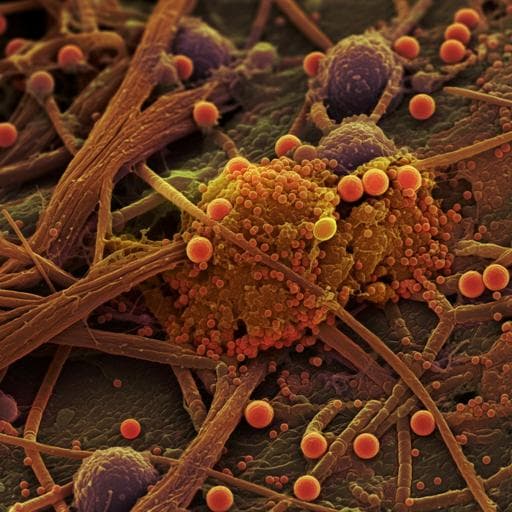
Agriculture
Soil microbial metabolism on carbon and nitrogen transformation links the crop-residue contribution to soil organic carbon
Z. Xie, Z. Yu, et al.
Discover how microbial metabolic processes reshape soil organic carbon accumulation in response to nitrogen supply from crop residues. This groundbreaking research by Zhihuang Xie, Zhenhua Yu, Yansheng Li, Guanghua Wang, Xiaobing Liu, Caixian Tang, Tengxiang Lian, Jonathan Adams, Junjie Liu, Judong Liu, Stephen J. Herbert, and Jian Jin reveals the correlation between microbial activity and carbon sequestration, highlighting a pathway to enhance soil health.
~3 min • Beginner • English
Introduction
Crop residue return to soil is a common practice to maintain soil organic carbon (SOC) and productivity, with ~5 × 10^9 tons of residues produced annually worldwide. The transformation of residue C into SOC pools is complex and influenced by residue chemistry, microbial processes, and soil mineralogy. Research emphasis has shifted from humification and bulk SOC pools to microbial community responses because microbial composition and function underpin residue-C transformation. Residue nitrogen (N) is a dominant factor influencing degradability; N-rich legume residues decompose faster than high C/N non-legumes, suggesting residue-N may govern SOC sequestration and stability by altering SOC molecular composition and distribution between particulate and mineral-associated pools. Plant-derived aliphatic compounds are more recalcitrant than O-alkyl compounds, and microbial accessibility differs between SOC pools. However, debates persist due to limited integrative metagenomic understanding of how microbial C and N metabolisms link residue-C flow into SOC pools. Metagenomics enables profiling of gene families for decomposition of labile to recalcitrant C and organic N mineralization, offering a route to resolve these mechanisms. Here, the authors hypothesize that microbial metabolisms of residue C and N are integrated to facilitate SOC sequestration and stability, strongly dependent on residue-N. Using 15N-labeled residues in a degraded Mollisol, they combined metagenomics, SOC fractionation, and 13C NMR to assess microbial functional profiles, community composition, and their contributions to residue-induced C accumulation in SOC pools and SOC molecular shifts, aiming to advance mechanistic understanding to guide residue management for SOC balance in agriculture.
Literature Review
Prior work shows: (1) Legume (N-rich) residues decompose faster than high C/N non-legumes, implying residue-N controls degradability and potential SOC sequestration (e.g., Blair et al.; Ma et al.). (2) SOC composition and distribution between particulate organic carbon (POC) and mineral-associated organic carbon (MOC) influence stability, with aliphatic compounds generally more recalcitrant than O-alkyl forms and physical accessibility governing turnover (Lorenz et al.; Dungait et al.). (3) Microbial community composition shifts with residue inputs and is linked to SOC accrual in fractions (Lian et al.). (4) Metagenomic/functional profiling can connect microbial gene repertoires to C and N cycling dynamics (Zhou et al.; He et al.). These studies set the context that nutrient stoichiometry and microbial functional potential mediate residue-C fate, but an integrated gene-to-SOC-pool linkage under varying residue-N has been lacking.
Methodology
Soil and residues: Mollisol (Phaeozem) collected from 0–10 cm at Guangrong village, Hailun, NE China (soybean–maize rotation without fertilization for 6 years). Soil prepared (air-dried to ~32% field water capacity, 2-mm sieved). Soil properties: pH 6.13, SOC 23.3 mg g−1, total N 2.01 mg g−1. 15N-labeled soybean and maize residues were produced by pot-growing plants in the Mollisol with Ca(NO3)2 (20% 15N atom excess, 100 mg N kg−1 soil). After maturity, stalks were dried, ground, and 0.25–2 mm fraction used. Residue chemistry: soybean 477 mg C g−1 and 9.3 mg N g−1 (C/N 51); maize 431 mg C g−1 and 4.1 mg N g−1 (C/N 105).
Experimental design: 250-day incubation at 25 °C with three treatments: maize residue, soybean residue, and no-residue control; n=3 per sampling time, 5 sampling times (7, 30, 60, 100, 250 days), 15 jars per treatment. Thirty grams air-dried soil pre-incubated 20 days at 25 °C at 50% field capacity, then mixed with 0.6 g residue, packed into PVC cores (5 cm height, 4 cm diameter; nylon mesh bottom), adjusted bulk density to 1.1 g cm−3, placed in 1-L sealed jars with NaOH CO2 traps and water vials to maintain humidity. Incubation in the dark; soil water maintained at 60% field capacity.
Sampling and measurements: At each time, soils were split for (i) air-drying to measure total C and N, SOC functional groups by 13C NMR, and 15N abundance; (ii) −80 °C storage for DNA extraction and sequencing; (iii) fresh measurements of microbial biomass C (MBC) and available N. Soil respiration measured by NaOH trapping and titration; microbial metabolic quotient qCO2 = respiration/MBC. Soil pH measured in 1:5 soil:water extracts; SOC measured by Elementar analyzer after HCl fumigation to remove carbonates; available N extracted with 0.5 M K2SO4 and analyzed by flow-injection. 15N abundance measured by IRMS.
SOC fractionation: At end of incubation (250 days), SOC separated into coarse POC (>250 μm), fine POC (53–250 μm), and MOC (<53 μm) using density (NaI, 1.7 g cm−3), dispersion (sodium hexametaphosphate), and sieving. C, N, and atom% 15N measured in each fraction.
Solid-state 13C NMR: Samples pre-treated with 2% HF; spectra acquired on Bruker Avance Neo 400 with 4-mm rotors, MAS 8 kHz, contact 2 ms, recycle delay 2.5 s, ~10,000 scans. Chemical shift regions: alkyl C (0–45 ppm), O-alkyl C (45–110 ppm), aromatic C (110–160 ppm), carboxyl/amide/ester C (160–200 ppm); indices calculated: alkyl/O-alkyl and aliphatic/aromatic.
Microbial community sequencing: DNA extracted (FastDNA SPIN Kit for Soil). Amplicon libraries for bacteria (16S rRNA V4–V5: 515F/907R) and fungi (ITS1F/ITS2R); sequenced on Illumina MiSeq. Quality filtering (QIIME), reads rarefied (24,250 bacteria; 30,892 fungi), OTUs at 97% similarity (UPARSE). Taxonomy via Greengenes (13_8) for bacteria and UNITE for fungi. SRA accessions: PRJNA729887 (bacteria), PRJNA729909 (fungi).
Metagenomics: DNA from days 7 and 250 used for shotgun metagenomes (Illumina HiSeq X Ten). Reads cleaned with fastp; assembly with MEGAHIT (kmer_min=47, kmer_max=97, step=10); contigs ≥300 bp for ORF prediction (MetaGene); ORFs ≥100 bp translated. Nonredundant gene catalog built with CD-HIT (90% coverage/identity). Read mapping with SOAPaligner; functional annotation with DIAMOND against KEGG (v94.2, e-value ≤1e−5). Normalization via DESeq2 RLE. Target KEGG Orthologs representing C- and N-metabolic pathways selected (Supplementary Table 1).
Community and network analyses: PCoA (UniFrac) and RDA (vegan, GUniFrac in R) to assess community differences and associations with SOC properties; statistical tests via ANOSIM and Adonis. Pearson correlations between gene read numbers and SOC composition/POC-MOC C and N visualized on heatmaps. Co-occurrence networks (WGCNA) built for bacterial and fungal OTUs (filtering OTUs <0.01% abundance), Spearman correlations (r>0.8, p<0.05), visualized in Gephi. Modules (ecological clusters) quantified by z-score standardized relative abundances. Functional genera associated with C-decomposition and N-mineralization identified using Spearman R^2>0.7, FDR q<0.05. Isotope calculations for 15N-derived residue-N in SOC fractions followed standard δ15N equations to compute %Ndfr, residual proportion RPNi, and residue-N amounts. Statistics: one-way ANOVA for three treatments; t-tests for pairwise comparisons (SPSS v19.0).
Key Findings
- Residue amendment markedly shifted microbial community composition relative to control over time. For bacteria, ANOSIM R=0.64, p<0.001; Adonis R^2=0.42, p<0.001. Fungal communities were also altered, with significant differences between maize and soybean treatments evident by day 250; for fungi, Adonis Residue R^2=0.63, p<0.001; Time R^2=0.03, p<0.01; ANOSIM Residue R=0.83, p<0.001.
- Community composition at day 250 was strongly associated (RDA) with SOC properties: positive relationships with C and N concentrations in fine POC and MOC and with O-alkyl C proportion (p<0.05), and negative with aromatic C proportion and alkyl/O-alkyl ratio (p<0.05).
- Residue amendment increased abundances of N-mineralization genes (urease, glutaminase, leucyl aminopeptidase, glutamate dehydrogenase, glutamate synthase) at days 7 and 250, relative to controls. At day 250, soybean residues had higher abundances of glutamate dehydrogenase, leucyl aminopeptidase, and aminopeptidase N genes, while maize residues had higher urease, glutamate synthase, and glutaminase genes.
- C-degradation genes increased significantly with residue inputs. Early (day 7), genes for labile C (hemicellulose, pectin, cellulose, chitin) were more abundant under soybean than maize; by day 250, abundances for chitin, aromatics, and lignin mineralization genes were similar between residue types.
- Network analyses linked microbial metabolic profiles to SOC composition and SOC fraction C and N: C-decomposition and N-mineralization genes were positively associated with O-alkyl C, and negatively with aromatic C and alkyl/O-alkyl ratio. N-mineralization genes (e.g., glutamate dehydrogenase, leucyl aminopeptidase, aminopeptidase N) were positively associated with residue-derived N in fine-POC and MOC at both 7 and 250 days. N concentrations in SOC fractions showed more positive connections with C-decomposition genes than with N-mineralization genes.
- Ecological network modularity identified 6 modules (modularity=0.60); modules 1–3 comprised 65.9% of nodes. Residue amendment increased abundances of modules 2 and 3 at both 7 and 250 days. Module 2 abundance correlated with normalized reads of C-decomposition and N-mineralization genes (R^2=0.57, p<0.001), indicating a keystone functional cluster. Dominant taxa in module 2 included Massilia, Dyella, Luteimonas, Sphingomonas (Proteobacteria), Granulicella (Acidobacteria), and fungi Penicillium and Ramophialophora, many enriched by residue amendments.
- SOC pool responses: Residue amendments increased C and N in SOC fractions; N-enriched soybean residues increased C concentration in POC more than maize residues and contributed more residue-N to POC. MOC also increased under residue amendments, implying enhanced organo-mineral associations. Residue treatments reduced soil mineral N relative to control, indicating N limitation and microbial N mining.
- SOC composition changes: Proportional increase in aliphatic C (and higher aliphatic/aromatic ratio) with residue amendments; microbial N-metabolism genes (urease, glutamate synthase, glutaminase) correlated positively with aliphatic C metrics, supporting roles in forming more persistent organic compounds. Recalcitrant C-degradation gene increases were smaller than for labile C, consistent with stabilization via physical and chemical protection.
Discussion
Findings support the hypothesis that microbial C and N metabolisms are integrated and residue-N dependent in driving SOC sequestration and stabilization. Residue inputs, especially N-richer soybean residues, stimulated microbial functional genes for both N mineralization and C decomposition, coinciding with increased C and N in fine POC and MOC and shifts in SOC molecular composition toward more aliphatic, less aromatic forms. The strong RDA associations and co-occurrence network linkages demonstrate that community composition and keystone modules underpin functional capacities that channel residue-derived C and N into stable SOC pools. Positive associations of N-mineralization genes with residue-N in POC/MOC and with aliphatic C indicate that microbial N processing facilitates biochemical transformations and substrate formation conducive to long-term stabilization (e.g., hydrophobic aliphatic biomacromolecules) and to physical protection (aggregation and organo-mineral interactions). Reduced mineral N in residue-amended soils suggests microbial N mining that is coupled to residue-C utilization, aligning with nutrient stoichiometry theory where high residue C/N constrains C assimilation without concurrent N acquisition. Together, the results mechanistically explain why N-enriched residues enhance SOC accrual and stability in agricultural Mollisols and highlight specific taxa and modules likely mediating these processes.
Conclusion
Crop residue amendments reshape soil microbial communities and elevate gene abundances for N mineralization and C degradation, coordinating residue C and N transformation into SOC. Residue-N availability modulates these microbial functions, promoting accumulation of C and N in fine POC and MOC and shifting SOC chemistry toward more persistent aliphatic forms. Keystone ecological modules (e.g., taxa including Massilia, Dyella, Luteimonas, Sphingomonas, Granulicella, Penicillium) are closely linked to functional genes, indicating targets for managing residue-driven SOC sequestration. This integrative metagenomics–SOC chemistry framework elucidates microbially mediated pathways by which residue-N enhances SOC stock and stability. Future work should test generality across soil types and climates, quantify causal contributions of identified modules/taxa (e.g., via manipulative experiments), and explore residue management strategies (residue mixtures, N supplementation, timing) that optimize microbial functions for SOC stabilization.
Limitations
- Laboratory incubation in a single Mollisol under controlled temperature and moisture may not capture field variability (climate fluctuations, plant–soil feedbacks, bioturbation) or generalize to other soils.
- Two residue types and one residue rate were tested; broader residue chemistry spectra, rates, and mixtures were not evaluated.
- Metagenomic snapshots at two time points (days 7 and 250) may miss intermediate dynamics and expression-level regulation; functional gene abundance does not equal in situ activity (no metatranscriptomics/proteomics or enzyme assays included for all pathways).
- SOC fractionation and 13C NMR were performed at the end-point, limiting temporal resolution of SOC compositional changes.
- Network correlations are associative; causal roles of keystone taxa and modules require validation (e.g., isolation, perturbation, or stable isotope probing at taxon level).
Related Publications
Explore these studies to deepen your understanding of the subject.







